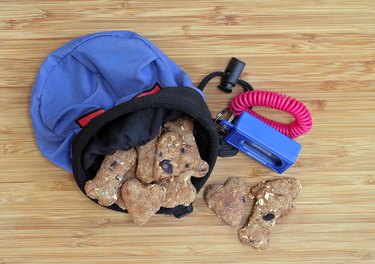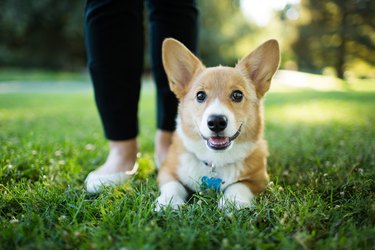
Do you know what good dog training looks like? Finding the right trainer isn't always easy., and it's hard to know where to start if you're a beginner. The good news is that all dogs, regardless of size, age, and breed or mix, can benefit from training.
However, all training is not created equally, In fact, bad training can be worse than no training at all. Dog training in the United State is an unregulated industry, which can make it challenging for dog parents to find a good trainer for their dog, or even to know where to begin. Bad training that utilizes punishment and outdated training methods can cause your dog's behavior to get worse instead of better. Good training focuses on positive reinforcement techniques and is based in the most up-to-date science.
Video of the Day
Video of the Day
When should you start training?
Dogs and puppies all enjoy learning new things, and it's never too early or too late to start training a dog or puppy. As soon as your new dog or new puppy comes home, you can give them a couple days to settle in. Then, it's a good time to start introducing them to training. (Just make sure your puppy has all the necessary vaccinations in order to do any outdoor training or group socialization!)
The goal with dog training should always be to make the experience fun and engaging for your dog. Training helps your dog to understand the expectations you have for their behavior in the home, and with their new family. Most importantly, training can be a great source of bonding for dogs and their families. Training together helps you and your dog to build a shared language, and can decrease miscommunication, and conflict between you and your dog.
Make sure to go at your dog or puppy's pace, take lots of breaks, and keep training sessions short!

Managing your dog's environment
Management means setting up an environment to prevent or minimize behaviors that are problematic. This might look like closing the blinds for a dog who barks when they see people outside, or keeping a dog who excitedly jumps on guests on a leash when guests enter the home. The examples are limitless and you can get as creative as you need to get.
Management solutions can be temporary or they can be an ongoing part of a dog's life. Many dogs need some degree of management in their environment at all times, but it's especially important when a dog is in a new environment. (A qualified trainer can help you with management in addition to other training!)
What is positive reinforcement training?
When getting ready to start training your dog, it's important to find a trainer who is utilizing positive reinforcement training approaches. Positive reinforcement trainers don't punish dogs for undesirable behaviors. Instead, they use what is motivating to a dog: food, play, toys, and praise to reward a dog for the behavior that we do want. Positive reinforcement training techniques are effective ways to teach dogs everything from basic obedience to complex sports.
Positive reinforcement training can even be used to work through unwanted behaviors. This type of training is effective because behaviors that are rewarded are more likely to be repeated. This means that if you reward your dog for doing a specific thing, they are going to repeat that behavior in the future instead of repeating the behaviors you don't like.

Is everyone having fun?
Good dog training should be fun and positive for dogs and people. You and your dog should be having fun with dog training, no matter what you are working on. Even when working on behavioral modification plans, it's important to keep training sessions fun and successful.
We want our dogs to be enthusiastic learners and eager to keep training. This means utilizing positive reinforcement approaches focusing on maintaining a high rate of reinforcement with treats, toys, play, and praise. By reinforcing the behaviors, we like and want our dogs to repeat in the future with treats we build value in that behavior for our dogs. If your dog seems shut down, or not engaged in training, that's a sign you might need to change up your training routine, or find a new trainer.
What kind of dog training options are there?
Unfortunately, many dog parents wait until they are experiencing behavior problems before finding a dog trainer to work with. Dog trainers can help you to get a puppy off on the right paw, help address or prevent anxiety and other behavioral issues. Dog training can also help you to bring more enrichment into your dog's life. A dog trainer can also support you to prepare your dog for transitions in your home and family, such as moving or adding a new pet to the family.
Your dog might benefit from individual training or group training classes (or both). Consulting with a qualified trainer can help you determine which is the right choice for you and your family.
Did You Know?
Contemporary dog trainers don't use the word "command" anymore, but use the word "cue" instead.
Some trainers also avoid the word "obedience," so instead of "Basic Obedience," a training class might be called something like "Basic Manners."
What makes a trainer qualified?
Dog training in the United States is an unregulated industry, meaning that anyone can call themself a dog trainer and begin working with dogs and their owners. This can mean that loving pet parents can unintentionally hire an inexperienced trainer, or a trainer who utilizes aversive tools or techniques which can be harmful to your dog.
When looking for a qualified dog trainer, look for trainers who are up to date on, and speak knowledgeably about, science-based training approaches. It's important to seek out trainers who center the use of positive reinforcement training approaches for working with all dogs. Similarly, look for dog trainers who utilize force-free and fear free training and handling approaches. Ask potential trainers what kind of affiliations and certifications they have. A good trainer will have verified experience around the type of training you're looking to do, and will prioritize continuing education to help them to learn more about dog training and how to best support dogs and their people.

How to find a qualified trainer
Look for dog trainers who are members of the Association of Professional Dog Trainers (APDT), and dog trainers who have achieved certification through the Certification for Professional Dog Trainers CCPDT. CPDT has a directory which can be helpful for finding a dog trainer in your local area. Both of these organizations utilize a LIMA (Least Invasive Minimally Aversive) approach to training, and affiliated trainers must adhere to centering positive reinforcement methods when working with dogs. When looking for a dog trainer, ask questions about a prospective trainer's experience, and don't be afraid to ask for references.
Dog trainer red flags
A big red flag is trainers who use outdated concepts and approaches to training. Avoid working with dog trainers who call themselves "balanced," meaning they use punishment-based approaches to working with dogs. Similarly, you'll want to avoid working with a dog trainer who uses terms and concepts like "alpha" and "dominance" as these theories have been disproven, and shown to be harmful for dogs. Avoid working with dog trainers who utilize aversive tools such as prong collars, or shock/e-collars. If you are ever unsure, don't be afraid to ask the trainer questions about their methods. They should be willing to answer questions freely. If you get a bad feeling about a trainer, or they are unwilling to answer basic questions, look elsewhere.

What about when dogs "misbehave"?
Living in a human house and culture can be confusing for dogs. Sometimes dogs are going to do things that we don't like. Your dog's "misbehavior" is a sign that they don't have the skills or information needed to make a different behavioral decision at that moment.
Punishing or "correcting" your dog after they have done something won't help your dog understand what you don't want them to do. Instead, it will make your dog confused, and can make them fearful or distrustful of you. Instead of punishing, focus teaching your dog alternative behaviors to the ones you don't like. (A qualified trainer can help you do this.)
Trust your judgement
If you start working with a new dog trainer it is always appropriate to ask questions about why they are handling your dog in a specific way, or why they want you to do something with your dog. If at any point you feel like the dog trainer is being rough, using tools you don't agree with, or doing something that makes your or your dog uncomfortable you can stop that training session. If your dog is exhibiting signs of stress, or seems uncomfortable, it's appropriate to request the training session end, or that your dog's discomfort be respected. Your dog relies on you to keep them safe. It's always ok to put your dog's comfort first.
The bottom line
You can begin training your dog or puppy as soon as they're settled at your home. Just make sure to have lots of patience and go at their pace.
Good dog trainers will be able to help you and your dog be comfortable with the learning process, while staying up to date on the science of dog training. When looking for a dog trainer, it's important to find a certified professional who utilizes positive reinforcement training approaches. Dog training should be fun for dogs and people. Make sure any trainer you hire is someone who both you and your dog feel comfortable with, who will help get you and your dog started on the right paw.